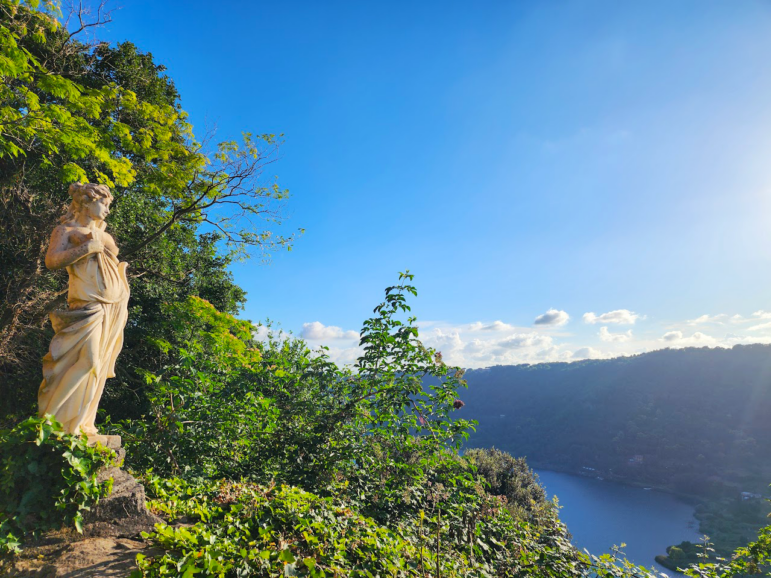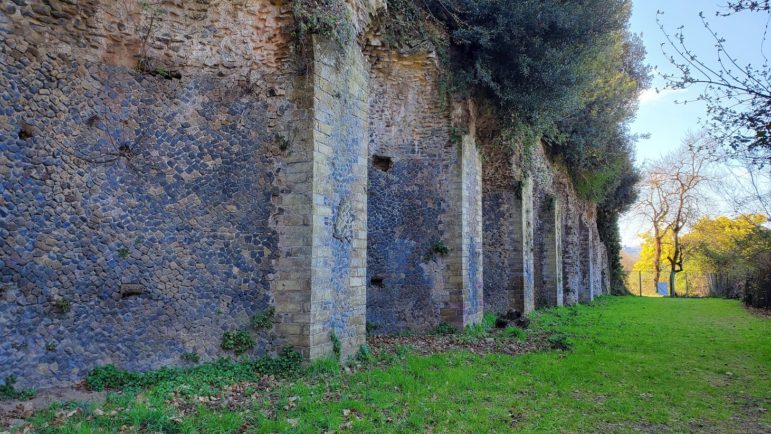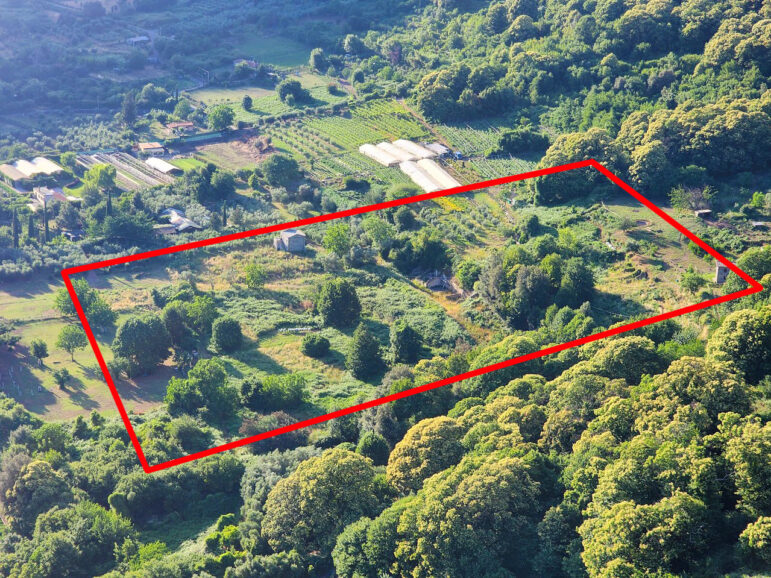ROME – The National Recovery and Resilience Plan for Italy announced a two-million-euro major restoration project at the Sanctuary of Diana in the town of Nemi. The funds are under a program called Jubilee Routes 2025: From Pagan Rome to Christian Rome (“PERCORSI GIUBILARI 2025: DALLA ROMA PAGANA ALLA ROMA CRISTIANA”).
A Vatican Jubilee year, also known as a Holy Year, is a special year of remission of sins and universal pardon in the Catholic Church. It is a time of pilgrimage, prayer, and penance, marked by special celebrations and the granting of indulgences. The first Christian Jubilee was proclaimed by Pope Boniface VIII in 1300, and intended to be celebrated every hundred years. Over time, the frequency of Jubilee years increased, and now Ordinary Jubilees occur every 25 years. The next Jubilee is scheduled to begin in 2025.

A statue of Diana Nemorensis overlooking the Sanctuary in Nemi, Italy [Photo Credit: M. Moreno June 24, 2024
In preparation for the Jubilee year, construction and restoration projects are underway in Rome. The projects range from extensive cleaning of buildings to local restoration of relics. One aspect of Jubilee-related funds is to improve access and tourism throughout Rome. For example, a major initiative costing about 4 billion euros aims to make the entire city more accessible to those with mobility issues.
The fund for these massive projects is part of Italy’s National Recovery and Resilience Plan (PNRR). The PNRR is Italy’s strategy for implementing the Next Generation EU program, initiated by the European Union to supplement the 2021-2027 Multiannual Financial Framework (MFF) in response to the economic and social impacts of the COVID-19 pandemic.

Grottos in the Sanctuary of Diana at Nemi [MJTM]
This Plan is guided by policy objectives and actions tied to the three strategic pillars established at the European level: digitalization and innovation, ecological transition, and social inclusion. The PNRR aims to address the profound changes brought by the dual ecological and digital transitions that require robust public-private collaboration. The PNRR also has important social objectives, such as strengthening women’s roles in society, combating gender discrimination, and improving youth employment skills and opportunities.
On June 11, 2024, the office of Premier Giorgia Meloni released a document of forthcoming Jubilee-related projects with PNRR funding. The restoration of the Sanctuary of Diana Nemorensis was green-lighted under the “From Pagan Rome to Christian Rome” projects in late April 2024.
The funding of the Sanctuary appears to have been assigned to the Soprintendenza Speciale Di Roma, which supervises archeological sites in Rome. The funding seems to have been allocated to the Soprintendenza via the Ministry of Tourism from the Ministry of Economy and Finance.
Recent excavations of the Sanctuary have shown the site to be far larger than previously believed. The site was forcibly closed by the Christianization of the Roman Empire and the persecution of Pagans, but the area was famously reintroduced into modernity by Sir James Frazer in his seminal work on the anthropology of religion, The Golden Bough.
Diana is a major goddess in both antiquity and modern Paganism, where she is venerated by multiple spiritual practices. She is the only Pagan goddess mentioned in the New Testament, and she remains associated with many folk beliefs, even among practitioners of Christianity.
Current estimates suggest the Sanctuary of Diana is roughly three times the size of St. Peter’s Square in the Vatican. The funding aims not only to restore the archeological buildings but also to develop wooden paths through the Sanctuary for tourism.
The release of the document identifying the new project at the Sanctuary occurred just before the June solstice. At a recent local solstice celebration, Pagans in the Nemi area shared their thoughts on the matter. They noted that the Sanctuary has already been affected by private land grabs. Silvanus, who declined to share his secular name, said he is torn by the funding. He hopes for new discoveries and a permanent secure future for the site while also recognizing the land, woods, and site are sacred.
The town of Nemi has been systematically acquiring property since 2000 to secure the Sanctuary. The town has also been engaged in plans to promote the Sanctuary, but TWH was unable to determine the town’s role in the current funding.
The development of the Sanctuary for tourism has raised some concerns, given the sacred nature of the site. Even now, there are makeshift altars and offerings throughout the Sanctuary site. Others in Silvanus’ group noted, and TWH journalists reported, that the Sanctuary remains an active site of reverence. The site is frequented by individuals who leave offerings on an altar within the Sanctuary, and ritual remains are occasionally visible, with drumming frequently heard in the adjacent woods on full moons and other Pagan occasions.

Approximate size of the Sanctuary of Diana Nemorensis. The image shows the remains of the Sanctuary and the adjacent Nyphaeum in Nemi, Italy [Photo Credit S. Ciotti- Date: June 24, 2024]
The Wild Hunt contacted archeologists involved in previous excavations of the site, and they all agreed that excavations should continue but did not have enough information to comment on the paths. Everyone TWH spoke with was clear: they hope any tourism project developed at the Sanctuary is created in a respectful manner that honors the sacred history of the site and the reverence that modern Pagans have for Diana Nemorensis.
Silvanus’s companion, Ana, added that she hopes the genius loci are honored and that whatever comes in terms of wooden paths does not disturb them or the meaning of the Sanctuary.
The Wild Hunt is not responsible for links to external content.
To join a conversation on this post:
Visit our The Wild Hunt subreddit! Point your favorite browser to https://www.reddit.com/r/The_Wild_Hunt_News/, then click “JOIN”. Make sure to click the bell, too, to be notified of new articles posted to our subreddit.